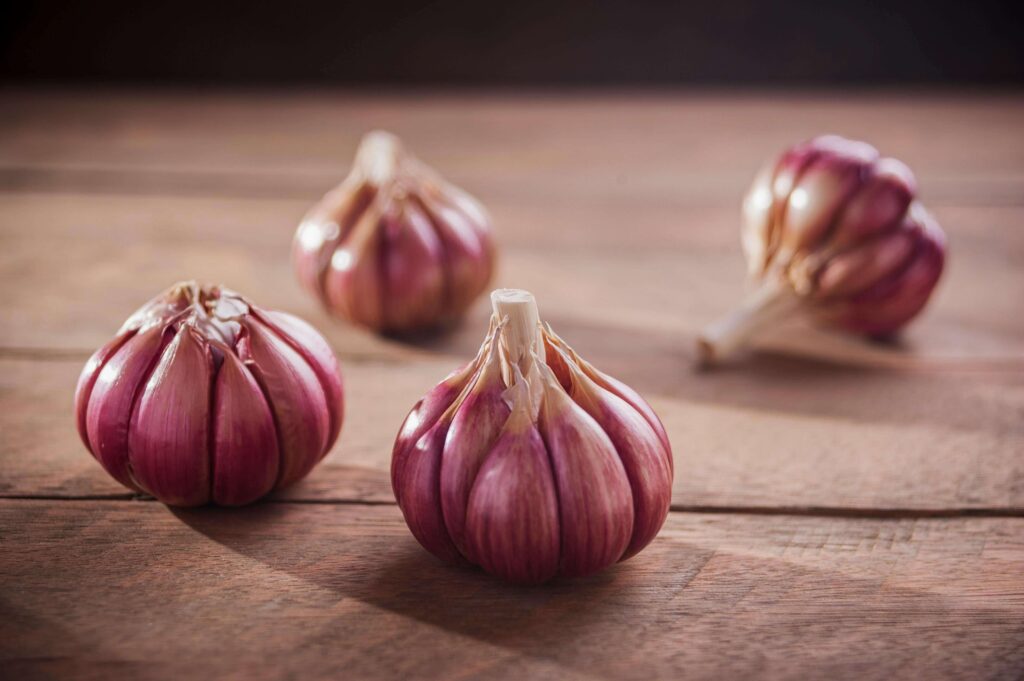 When it comes to garlic, most people are familiar with the standard white variety found in kitchens worldwide. However, there’s a lesser-known but equally fascinating type of garlic that’s starting to gain attention — purple garlic. With its vibrant color, unique flavor profile, and an array of health benefits, purple garlic is becoming a favorite among chefs, health enthusiasts, and home gardeners alike. In this blog post, we’ll dive into what purple garlic is, its benefits, its culinary uses, and why you should consider adding it to your kitchen.
When it comes to garlic, most people are familiar with the standard white variety found in kitchens worldwide. However, there’s a lesser-known but equally fascinating type of garlic that’s starting to gain attention — purple garlic. With its vibrant color, unique flavor profile, and an array of health benefits, purple garlic is becoming a favorite among chefs, health enthusiasts, and home gardeners alike. In this blog post, we’ll dive into what purple garlic is, its benefits, its culinary uses, and why you should consider adding it to your kitchen.
What is Purple Garlic?
Anthocyanins, which are the same antioxidants that give berries and grapes their rich red and purple colors, are what give purple garlic its unique color. These pigments not only contribute to its vibrant appearance but also pack a punch when it comes to its health benefits.
While it may look different from the traditional white garlic, purple garlic is actually the same species — Allium sativum. What distinguishes it is the way it’s grown and harvested. Purple garlic varieties often come from specific regions around the world, including parts of Europe and Asia, and they tend to have a more robust, more pungent flavor compared to their white counterparts.
Types of Purple Garlic
There are several types of purple garlic, each with its unique characteristics. The most common varieties include:
- Purple Stripe: This variety is characterized by its purple and white stripes on each clove. It has a robust flavor that becomes even more intense when roasted.
- Creole: Well-known for its pinkish-purple color, Creole garlic is a popular option for people who prefer a more subdued flavor.
- Rocambole: A hardneck garlic with a rich purple color, Rocambole is often considered one of the best-tasting garlic varieties. Depending on how it is made, its buttery, smooth flavor can be either sweet or spicy.
Health Benefits of Purple Garlic
Garlic, in general, is celebrated for its impressive health benefits, and purple garlic is no exception. Here are some reasons why you might want to incorporate it into your diet:
- Rich in Antioxidants
The anthocyanins responsible for the purple color of garlic are potent antioxidants. By helping the body fight off harmful free radicals, these compounds reduce the body.
Garlic’s ability to strengthen the immune system is well known. It contains sulfur compounds like allicin, which have antibacterial, antiviral, and antifungal effects. This makes purple garlic an excellent natural remedy for fighting off colds, flu, and other infections.
- Supports Heart Health
It has been demonstrated that the sulfur compounds in garlic, such as allicin, lower blood pressure, cholesterol, and enhance blood circulation. Regular consumption of garlic, including purple garlic, may help lower your risk of cardiovascular diseases.
- Anti-Inflammatory Properties
Purple garlic has been shown to have significant anti-inflammatory effects. Chronic inflammation has been connected to a number of illnesses, such as asthma, arthritis, and even some cancers. Garlic’s ability to fight inflammation may help manage these conditions and improve overall well-being.
- Detoxifies the Body
Garlic is also a natural detoxifier. It helps stimulate the production of liver enzymes that help flush toxins from the body. Regular consumption of purple garlic can support your body’s natural detoxification processes.
Culinary Uses of Purple Garlic
Purple garlic’s bold flavor makes it an excellent addition to many dishes. Here are a few ways you can use it in the kitchen:
- Roasting: Roasting garlic softens its pungency and brings out a sweet, caramelized flavor. Purple garlic is perfect for roasting and can be spread on toast, added to mashed potatoes, or incorporated into soups and stews.
- Sautéing and Stir-Frying: If you prefer a sharper, more intense flavor, purple garlic can be sautéed or stir-fried. It adds depth and complexity to any savory dish, from pasta sauces to vegetable stir-fries.
- Garlic Butter: Create a flavorful garlic butter by mincing purple garlic and combining it with softened butter, herbs, and a pinch of salt. This makes for a fantastic topping for meats, roasted vegetables, or fresh bread.
- Pickling: Garlic can also be pickled, which brings out its unique flavor while offering a tangy twist. Purple garlic pickles can be enjoyed as a snack or added to salads and sandwiches.
- Garlic Oil: Infusing olive oil with purple garlic creates a delicious aromatic oil that can be used for drizzling over salads, pasta, and grilled meats.
Growing Purple Garlic at Home
Purple garlic is not only a treat for your taste buds, but it’s also relatively easy to grow at home. If you have a garden or even a tiny balcony, you can grow your garlic. Here are a few tips:
- Planting: Plant garlic cloves in well-drained soil, preferably in the fall. Garlic needs a cold period to grow, so the colder months of the year are ideal for planting.
- Care: Garlic needs plenty of sunlight and should be watered regularly but not excessively. It thrives in loose, fertile soil with good drainage.
- Harvesting: Late spring to early summer is when garlic is usually ready to be harvested. Look for signs such as yellowing leaves and drying tips to know when it’s time to pull the bulbs from the ground.
- Storage: Once harvested, garlic bulbs should be cured in a dry, cool place for a few weeks before storing them. They can be kept in mesh bags or woven baskets in a dark, excellent location. Visit here for more info
Conclusion
Purple garlic is a flavorful and nutritious twist on the traditional garlic variety that can elevate your culinary creations while offering an array of health benefits. It is a must-try ingredient for anyone wishing to increase their culinary skills and enhance their health because of its vivid color, rich flavor, and potent medicinal qualities. Whether you’re roasting it, adding it to sauces, or growing it in your garden, purple garlic is a fantastic way to add flavor and wellness to your life.







